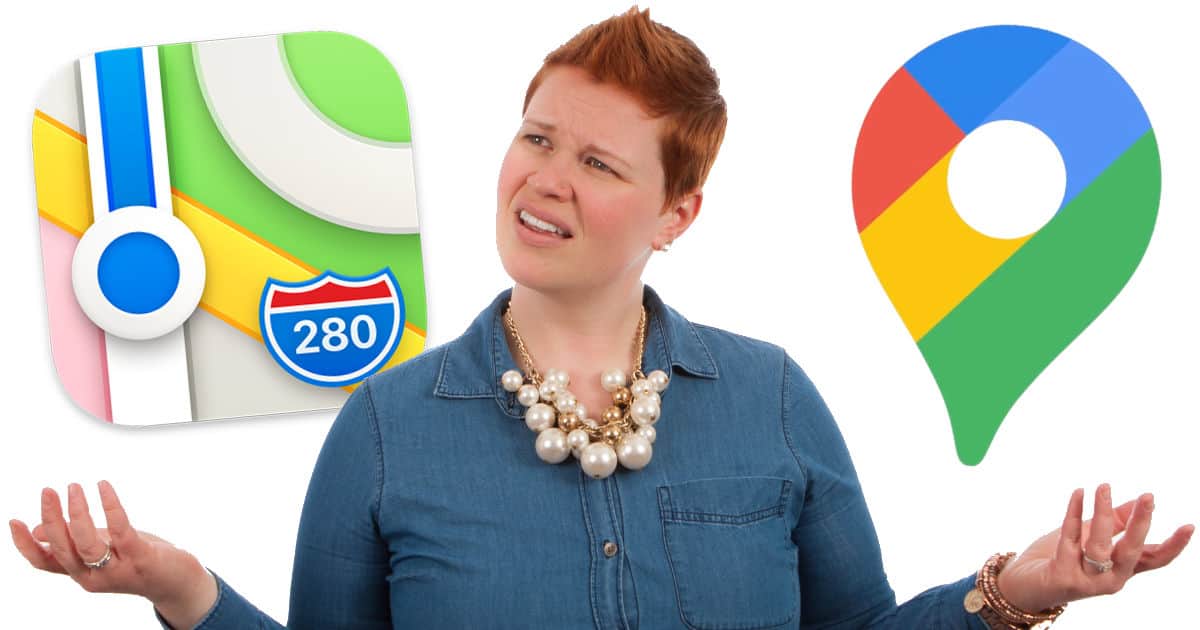Apple Maps has a business problem, and it will always play second string to Google Maps until it gets fixed. That problem is business listings, and right now Google is the clear leader.
Both Apple and Google Maps offer reliable driving directions, especially in urban areas. Walking directions, however, are more reliable in Google Maps. Google wins in finding accurate business information because it’s equally troublesome in Apple Maps for users and business owners.
Apple Maps Hobbled for Businesses
To start, there’s the issue with listing your business in Apple Maps. The Connect website for Apple Maps is pretty straightforward and easy enough to use, unless something goes wrong. If, for some reason, Apple has an issue confirming your business location, resolving the problem can be time consuming and frustrating even for the tech-savvy. Google’s business claiming website is well documented and easy to use and, at least anecdotally, has fewer registration and update issues.
Apple Maps also doesn’t support businesses without physical locations. If your business doesn’t have a store front or office space, Apple isn’t going to let you claim it in Maps. Google Maps, in contrast, supports businesses without storefronts along with businesses that have service areas. That means Apple Maps is currently limited to showing only a subset of business compared to Google Maps.
Then there’s awareness. Many companies don’t realize they need to claim their business in Apple Maps in addition to their Google Maps listing. Without both, they’re missing out on potential customers who’re business hunting on their iPhones. And there are plenty of iPhone users who don’t know there’s a difference between searching for businesses in Apple Maps versus Google—nor should they need to. The onus is on Apple and Google; users should be able to expect quality search results regardless of the maps app they’re using.
The Apple Maps Business Problem
For businesses, this is a real problem because Apple promotes its Maps app as the way to find retailers and other services on the iPhone, iPad, and Mac. It’s also what Siri uses when you say something like, “Hey Siri, find bakeries near me.” If your business is invisible depending on which search tool someone uses, you’re missing out on sales.
For customers, this means the best tool for business searches is Google and Google Maps, regardless of the smartphone, tablet, or computer they’re using.
Apple can improve the process to claim and update business listings, and it can work on making business owners aware of its Maps listing service. We haven’t, however seen any significant effort on Apple’s part to tell businesses its Maps listings even exist.
Even if Apple does get more companies on board with its Maps business listings, it may not be enough because of Google’s big advantage: its maps platform is tied directly to its search engine.
Right now, Google is the clear winner for businesses in maps. Regardless of what Apple does with map directions, it can’t replace Google Maps. What it can do is continue to offer tight integration with Apple’s other apps and services, which is great. Unfortunately, that’s at the expense of businesses hoping to find more customers.

I don’t use Google products.
I honestly did not know that businesses had to register to appear in GoogleMaps or AppleMaps. I just assumed they were scraping existing databases. Google especially would have all sorts of data from other sources. I just figured they ported that over to Maps.
No, I’ve handled the task before, and it’s not difficult, but does require your effort.
Apple’s site is simple, mainly due to the fact that it doesn’t allow for much customisation. Just the basic info submission and verification. It does take longer to process than Google.
Google is helped by the virtue that a Google account can handle the multitude of other services businesses may be interested in, like advertising.
It also allows the business to upload photos, and other things to help flesh out their business listing.
Yelp also requires a concerted effort to “claim” a business listing. The difference with it is that their sales team will then constantly pester you to buy advertising. Neither Apple nor Google will follow up with any sales pitches.
I should also add that it’s prudent to be proactive, make the effort, and take control of how each of these services present your business, at least if you care about the image your wish to project. Those that don’t, and as a result have minimal, or neglected profiles leave a bad impression. Or perhaps none at all, if they haven’t made to the effort to be listed.
I honestly did not know that businesses had to register to appear in GoogleMaps or AppleMaps. I just assumed they were scraping existing databases. Google